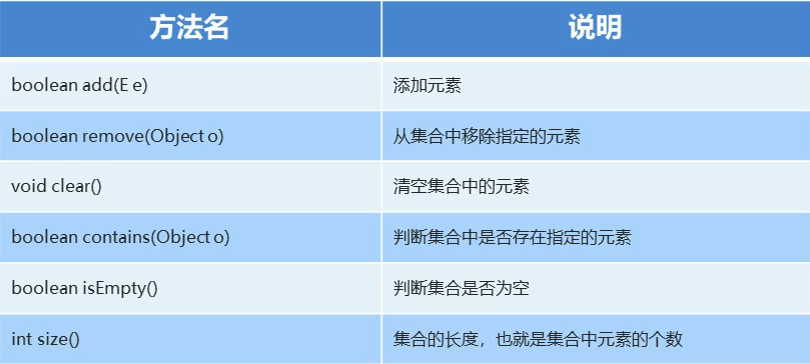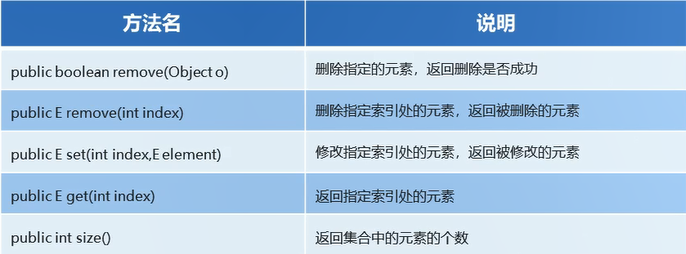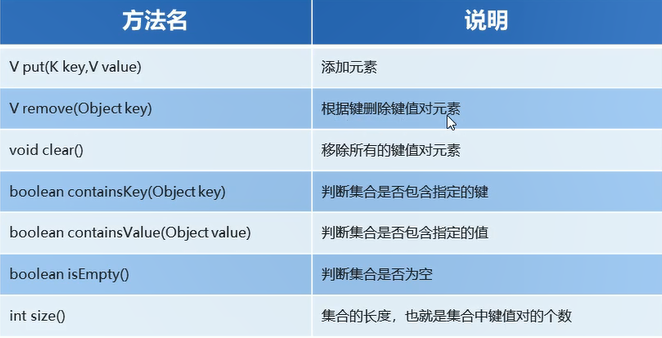1.1集合概述
集合类的特点:提供一种存储空间可变的存储模型,存储的数据容量可以发生变化,java集合类包含在java.util包下,集合类存放的是对象的引用,而非对象本身,集合类型主要分为Set,List和Map。
集合类有很多,首先学习ArrayList。
1.2java集合类图

1.3Collection集合概述和使用
- Collection是单例集合的顶层接口,它表示一组对象,这些对象也称为Collection的元素
- JDK不提供此接口的直接实现,它提供更具体的子接口(如Set和List)实现。
import java.util.ArrayList; import java.util.Collection; public class myCollection { public static void main(String[] args) { //创建Collection集合的对象 //Collection本身是一个接口,无法实例化,故此通过其List子接口的ArrayList实现类来实例化(多态) Collection<String> collection = new ArrayList<String>(); //给collection添加元素 collection.add("Hello"); collection.add("World"); //输出集合对象 System.out.println(collection);//ArrayList重写了toString()方法 } }
1.3.1Collection集合常用方法

1.3.2Collection集合的遍历
- Iterator:迭代器,集合的专用遍历方式
- Iterator<E> iterator():返回此集合中元素的迭代器,通过集合的iterator方法得到。
- 迭代器是通过集合的iterator()方法得到的,所以我们说它依赖于集合而存在。
//遍历 Iterator<String> it = collection.iterator(); while(it.hasNext()) {
String s = it.next(); System.out.println(s); }
1.4List集合
1.4.1List集合概述
- 有序集合,用户可以精确控制列表每个元素的插入位置,用户可以通过整数索引访问元素,并搜索列表中的元素。
- 与Set集合不同,列表通常允许重复的元素。
1.4.2List集合特点
- 有序:存储和取出的元素顺序一致
- 可重复:存储的元素可以重复
1.4.3List集合的特有方法

1.4.4并发修改异常
- 出现的原因
- 迭代器遍历的过程中,通过集合对象修改了集合中的元素,造成了迭代器获取元素中判断预期修改值和实际修改值不一致,则会出现:ConcurrentModificationException
- 解决的方案
- 用for循环遍历,然后用集合对象做对应的操作即可
- 示例代码
public class ListDemo { public static void main(String[] args) { //创建集合对象 List<String> list = new ArrayList<String>(); //添加元素 list.add("hello"); list.add("world"); list.add("java"); //遍历集合,得到每一个元素,看有没有"world"这个元素,如果有,我就添加一个"javaee"元素,请写代码实现 // Iterator<String> it = list.iterator(); // while (it.hasNext()) { // String s = it.next(); // if(s.equals("world")) { // list.add("javaee"); // } // } for(int i=0; i<list.size(); i++) { String s = list.get(i); if(s.equals("world")) { list.add("javaee"); } } //输出集合对象 System.out.println(list); } }
1.4.5列表迭代器
- ListIterator介绍
- 通过List集合的listIterator()方法得到,所以说它是List集合特有的迭代器
- 用于允许程序员沿任一方向遍历的列表迭代器,在迭代期间修改列表,并获取列表中迭代器的当前位置
public class ListIteratorDemo { public static void main(String[] args) { //创建集合对象 List<String> list = new ArrayList<String>(); //添加元素 list.add("hello"); list.add("world"); list.add("java"); //获取列表迭代器 ListIterator<String> lit = list.listIterator(); while (lit.hasNext()) { String s = lit.next(); if(s.equals("world")) { lit.add("javaee"); } } System.out.println(list); } }
1.4.6增强for循环
for(元素数据类型 变量名 : 数组/集合对象名) { 循环体; }
public class ForDemo { public static void main(String[] args) { int[] arr = {1,2,3,4,5}; for(int i : arr) { System.out.println(i); } System.out.println("--------"); String[] strArray = {"hello","world","java"}; for(String s : strArray) { System.out.println(s); } System.out.println("--------"); List<String> list = new ArrayList<String>(); list.add("hello"); list.add("world"); list.add("java"); for(String s : list) { System.out.println(s); } System.out.println("--------"); //内部原理是一个Iterator迭代器 /* for(String s : list) { if(s.equals("world")) { list.add("javaee"); //ConcurrentModificationException } } */ } }
1.4.7集合的案例-List集合存储学生对象三种方式遍历
- 学生类
public class Student { private String name; private int age; public Student() { } public Student(String name, int age) { this.name = name; this.age = age; } public String getName() { return name; } public void setName(String name) { this.name = name; } public int getAge() { return age; } public void setAge(int age) { this.age = age; } }
- 测试类
public class ListDemo { public static void main(String[] args) { //创建List集合对象 List<Student> list = new ArrayList<Student>(); //创建学生对象 Student s1 = new Student("林青霞", 30); Student s2 = new Student("张曼玉", 35); Student s3 = new Student("王祖贤", 33); //把学生添加到集合 list.add(s1); list.add(s2); list.add(s3); //迭代器:集合特有的遍历方式 Iterator<Student> it = list.iterator(); while (it.hasNext()) { Student s = it.next(); System.out.println(s.getName()+","+s.getAge()); } System.out.println("--------"); //普通for:带有索引的遍历方式 for(int i=0; i<list.size(); i++) { Student s = list.get(i); System.out.println(s.getName()+","+s.getAge()); } System.out.println("--------"); //增强for:最方便的遍历方式 for(Student s : list) { System.out.println(s.getName()+","+s.getAge()); } } }
1.4.8数据结构
1.4.8.1数据结构之栈和队列
- 栈结构
- 先进后出
- 队列结构
- 先进先出
1.4.8.2数据结构之数组和链表
- 数组结构
- 查询快、增删慢
- 链表结构
- 查询慢、增删快
1.5List集合的实现类
1.5.1List集合子类的特点
- ArrayList集合
- 底层是数组结构实现,查询快、增删慢
- LinkedList集合
- 底层是链表结构实现,查询慢、增删快
1.5.2ArrayList
ArrayList是List的子类,允许存放重复的元素,并且是有序的。
- ArrayList<E>:
- 可调整大小的数组实现
- <E>是一种特殊的数据类型--泛型,用于约束集合中存储元素的数据类型
1.5.2.1ArrayList构造方法和添加方法

- 示例代码
import java.util.ArrayList; public class ArrayListDemo01 { public static void main(String[] args) { ArrayList<String> array = new ArrayList<String>(); array.add("hello"); array.add("world"); array.add("java"); array.add(1,"javase"); //IndexOutOfBoundsException //array.add(4,"javaee"); System.out.println("array:" + array); } }
1.5.2.2ArrayList集合常用方法

- 示例代码
public class ArrayListDemo02 { public static void main(String[] args) { //创建集合 ArrayList<String> array = new ArrayList<String>(); //添加元素 array.add("hello"); array.add("world"); array.add("java"); //public boolean remove(Object o):删除指定的元素,返回删除是否成功 // System.out.println(array.remove("world")); // System.out.println(array.remove("javaee")); //public E remove(int index):删除指定索引处的元素,返回被删除的元素 // System.out.println(array.remove(1)); //IndexOutOfBoundsException // System.out.println(array.remove(3)); //public E set(int index,E element):修改指定索引处的元素,返回被修改的元素 // System.out.println(array.set(1,"javaee")); //IndexOutOfBoundsException // System.out.println(array.set(3,"javaee")); //public E get(int index):返回指定索引处的元素 // System.out.println(array.get(0)); // System.out.println(array.get(1)); // System.out.println(array.get(2)); //System.out.println(array.get(3)); //?????? 自己测试 //public int size():返回集合中的元素的个数 System.out.println(array.size()); //输出集合 System.out.println("array:" + array); } }
1.5.2.3ArrayList集合存储学生对象三种方式遍历
public class ArrayListDemo { public static void main(String[] args) { //创建ArrayList集合对象 ArrayList<Student> array = new ArrayList<Student>(); //创建学生对象 Student s1 = new Student("林青霞", 30); Student s2 = new Student("张曼玉", 35); Student s3 = new Student("王祖贤", 33); //把学生添加到集合 array.add(s1); array.add(s2); array.add(s3); //迭代器:集合特有的遍历方式 Iterator<Student> it = array.iterator(); while (it.hasNext()) { Student s = it.next(); System.out.println(s.getName() + "," + s.getAge()); } System.out.println("--------"); //普通for:带有索引的遍历方式 for(int i=0; i<array.size(); i++) { Student s = array.get(i); System.out.println(s.getName() + "," + s.getAge()); } System.out.println("--------"); //增强for:最方便的遍历方式 for(Student s : array) { System.out.println(s.getName() + "," + s.getAge()); } } }
说明:ArrayList是一个有序且允许重复和空值的列表。
1.5.3LinkedList
LinkedList是一种可以在任何位置进行高效地插入和删除操作的有序序列。
1.5.3.1LinkedList集合的特有功能

package com.boxiaoyuan.www;
import java.util.Iterator;
import java.util.LinkedList;
public class Demo03 {
public static void main(String[] args) {
LinkedList<String> linkedList = new LinkedList<String>();
linkedList.add("张三");
linkedList.add("李四");
linkedList.add("王五");
linkedList.add("赵六");
linkedList.add("闫七");
linkedList.add("张三");
linkedList.add(2, "赵晓鹏");
linkedList.push("李海");
linkedList.pop();
System.out.println("LinkedList输出顺序:");
Iterator<String> iterator = linkedList.iterator();
while(iterator.hasNext()) {
String string = iterator.next();
System.out.println(string);
}
}
}
---------输出结果-----------
LinkedList输出顺序:
张三
李四
赵晓鹏
王五
赵六
闫七
张三
说明:LinkedList是有序的双向链表,可以在任意位置进行元素的增加和删除,读取效率低于ArrayList,插入效率高。pop和push方法都是在队头开始的。
1.5Set集合
1.5.1Set集合概述
- Set集合的特点
- 元素存取无序
- 没有索引、只能通过迭代器或增强for循环遍历
- 不能存储重复元素
1.5.2Set集合的基本使用
public class SetDemo { public static void main(String[] args) { //创建集合对象 Set<String> set = new HashSet<String>(); //添加元素 set.add("hello"); set.add("world"); set.add("java"); //不包含重复元素的集合 set.add("world"); //遍历 for(String s : set) { System.out.println(s); } } }
1.5.3哈希值
1.5.3.1哈希值简介
是JDK根据对象的地址或者字符串或者数字算出来的int类型的数值
1.5.3.2如何获取哈希值
Object类中的public int hashCode():返回对象的哈希码值
1.5.3.3哈希值的特点
同一个对象多次调用hashCode()方法返回的哈希值是相同的,默认情况下,不同对象的哈希值是不同的。而重写hashCode()方法,可以实现让不同对象的哈希值相同。
public class HashDemo { public static void main(String[] args) { //创建学生对象 Student s1 = new Student("林青霞",30); //同一个对象多次调用hashCode()方法返回的哈希值是相同的 System.out.println(s1.hashCode()); //1060830840 System.out.println(s1.hashCode()); //1060830840 System.out.println("--------"); Student s2 = new Student("林青霞",30); //默认情况下,不同对象的哈希值是不相同的 //通过方法重写,可以实现不同对象的哈希值是相同的 System.out.println(s2.hashCode()); //2137211482 System.out.println("--------"); System.out.println("hello".hashCode()); //99162322 System.out.println("world".hashCode()); //113318802 System.out.println("java".hashCode()); //3254818 System.out.println("world".hashCode()); //113318802 System.out.println("--------"); System.out.println("重地".hashCode()); //1179395 System.out.println("通话".hashCode()); //1179395 } }
1.5.4HashSet
HashSet是Set接口的子类,主要特点是:
- 底层数据结构是哈希表
- 对集合的迭代顺序不作任何保证,也就是说不保证存储和取出的元素顺序一致
- 没有带索引的方法,所以不能使用普通for循环遍历
- 由于是Set集合,所以是不包含重复元素的集合
public class HashSetDemo01 { public static void main(String[] args) { //创建集合对象 HashSet<String> hs = new HashSet<String>(); //添加元素 hs.add("hello"); hs.add("world"); hs.add("java"); hs.add("world"); //遍历 for(String s : hs) { System.out.println(s); } } }
说明:HashSet存放的值是无序且不能重复的,可以存放null,但是只能存放一个null值。HashSet继承AbstractSet,有两个很重要的方法:HashCode和equals,当对象被存储到HashSet中时,会调用HashCode,获取对象的存放位置。
1.5.4.1HashSet集合保证元素唯一性的原理
1.根据对象的哈希值计算存储位置
- 如果当前位置没有元素则直接存入
- 如果当前位置有元素存在,则进入第二步
2.遍历当前位置的所有元素和新存入的元素比较哈希值
- 如果哈希值不同,则将当前元素进行存储
- 如果哈希值相同,则进入第三步
3.通过equals()方法比较两个元素的内容
- 如果内容不相同,则将当前元素进行存储
- 如果内容相同,则不存储当前元素
1.5.4.2HashSet集合存储学生对象并遍历
- 学生类
import java.util.Objects; public class Student { private String name; private String age; //Alt+Insert自动生成 public String getName() { return name; } public void setName(String name) { this.name = name; } public void setAge(String age) { this.age = age; } public String getAge() { return age; } public Student(String name, String age) { this.name = name; this.age = age; } //Alt+Insert自动生成 @Override public boolean equals(Object o) { if (this == o) return true; if (o == null || getClass() != o.getClass()) return false; Student student = (Student) o; return Objects.equals(name, student.name) && Objects.equals(age, student.age); } @Override public int hashCode() { return Objects.hash(name, age); } }
- 测试类
public class HashSetDemo { public static void main(String[] args) { HashSet<Student> hs = new HashSet<Student>(); Student s1 = new Student("张三", "18"); Student s2 = new Student("李四", "22"); Student s3 = new Student("李四", "22"); hs.add(s1); hs.add(s2); hs.add(s3); for(Student s : hs){ System.out.println(s.getName()+"---"+s.getAge()); } } }
1.5.5LinkedHashSet
1.5.5.1LinkedHashSet集合特点
哈希表和链表实现的Set接口,具有可预测的迭代次序,由链表保证元素有序,也就是说元素的存储和取出顺序是一致的,由哈希表保证元素唯一,也就是说没有重复的元素
LinkedHashSet是HashSet的一个子类,LinkedHashSet的底层用的是LinkedHashMap,HashSet的底层用的是HashMap。
1.5.5.2LinkedHashSet集合基本使用
package com.boxiaoyuan.www; import java.util.Iterator; import java.util.LinkedHashSet; public class Demo03 { public static void main(String[] args) { LinkedHashSet<String> linkedHashSet = new LinkedHashSet<String>(); linkedHashSet.add("张三"); linkedHashSet.add("李四"); linkedHashSet.add("王五"); linkedHashSet.add("赵六"); linkedHashSet.add("闫七"); linkedHashSet.add("张三"); System.out.println("LinkedHashSet输出顺序:"); Iterator<String> iterator = linkedHashSet.iterator(); while(iterator.hasNext()) { String string = iterator.next(); System.out.println(string); } } } ---------输出结果--------- LinkedHashSet输出顺序: 张三 李四 王五 赵六 闫七
说明:LinkedHashSet中存放的元素是有序,不能重复的。
1.5.6TreeSet
1.5.6.1TreeSet集合概述
元素有序,可以按照一定的规则进行排序,具体排序方式取决于构造方法
- TreeSet():根据其元素的自然排序进行排序
- TreeSet(Comparator comparator) :根据指定的比较器进行排序
没有带索引的方法,所以不能使用普通for循环遍历
由于是Set集合,所以不包含重复元素的集合
1.5.6.2TreeSet集合基本使用
public class TreeSetDemo01 { public static void main(String[] args) { //创建集合对象 TreeSet<Integer> ts = new TreeSet<Integer>(); //添加元素 ts.add(10); ts.add(40); ts.add(30); ts.add(50); ts.add(20); ts.add(30); //遍历集合 for(Integer i : ts) { System.out.println(i); } } }
1.5.6.3自然排序Comparable的使用
案例需求
- 存储学生对象并遍历,创建TreeSet集合使用无参构造方法
- 要求:按照年龄从小到大排序,年龄相同时,按照姓名的字母顺序排序
实现步骤
- 用TreeSet集合存储自定义对象,无参构造方法使用的是自然排序对元素进行排序的
- 自然排序,就是让元素所属的类实现Comparable接口,重写compareTo(T o)方法
- 重写方法时,一定要注意排序规则必须按照要求的主要条件和次要条件来写
代码实现
- 学生类
public class Student implements Comparable<Student> { private String name; private int age; public Student() { } public Student(String name, int age) { this.name = name; this.age = age; } public String getName() { return name; } public void setName(String name) { this.name = name; } public int getAge() { return age; } public void setAge(int age) { this.age = age; } @Override public int compareTo(Student s) { // return 0; // return 1; // return -1; //按照年龄从小到大排序,this代表新增加的元素 int num = this.age - s.age; // int num = s.age - this.age; //年龄相同时,按照姓名的字母顺序排序 int num2 = num==0?this.name.compareTo(s.name):num; return num2; } }
- 测试类
public class TreeSetDemo02 { public static void main(String[] args) { //创建集合对象 TreeSet<Student> ts = new TreeSet<Student>(); //创建学生对象 Student s1 = new Student("xishi", 29); Student s2 = new Student("wangzhaojun", 28); Student s3 = new Student("diaochan", 30); Student s4 = new Student("yangyuhuan", 33); Student s5 = new Student("linqingxia",33); Student s6 = new Student("linqingxia",33); //把学生添加到集合 ts.add(s1); ts.add(s2); ts.add(s3); ts.add(s4); ts.add(s5); ts.add(s6); //遍历集合 for (Student s : ts) { System.out.println(s.getName() + "," + s.getAge()); } } }
- 如果将compareTo()返回值写死为0,元素值每次比较,都认为是相同的元素,这时就不再向TreeSet中插入除第一个外的新元素。所以TreeSet中就只存在插入的第一个元素。
- 如果将compareTo()返回值写死为1,元素值每次比较,都认为新插入的元素比上一个元素大,于是二叉树存储时,会存在根的右侧,读取时就是正序排列的。
- 如果将compareTo()返回值写死为-1,元素值每次比较,都认为新插入的元素比上一个元素小,于是二叉树存储时,会存在根的左侧,读取时就是倒序序排列的。
1.5.6.4比较器排序Comparator的使用
案例需求
- 存储学生对象并遍历,创建TreeSet集合使用带参构造方法
- 要求:按照年龄从小到大排序,年龄相同时,按照姓名的字母顺序排序
实现步骤
- 用TreeSet集合存储自定义对象,带参构造方法使用的是比较器排序对元素进行排序的
- 比较器排序,就是让集合构造方法接收Comparator的实现类对象,重写compare(T o1,T o2)方法
- 重写方法时,一定要注意排序规则必须按照要求的主要条件和次要条件来写
代码实现
- 学生类
public class Student { private String name; private int age; public Student() { } public Student(String name, int age) { this.name = name; this.age = age; } public String getName() { return name; } public void setName(String name) { this.name = name; } public int getAge() { return age; } public void setAge(int age) { this.age = age; } }
- 测试类
public class TreeSetDemo { public static void main(String[] args) { //创建集合对象 TreeSet<Student> ts = new TreeSet<Student>(new Comparator<Student> () { @Override public int compare(Student s1, Student s2) { int num = s1.getAge() - s2.getAge(); int num2 = num == 0 ? s1.getName().compareTo(s2.getName()) : num; return num2; } }); //创建学生对象 Student s1 = new Student("xishi", 29); Student s2 = new Student("wangzhaojun", 28); Student s3 = new Student("diaochan", 30); Student s4 = new Student("yangyuhuan", 33); Student s5 = new Student("linqingxia",33); Student s6 = new Student("linqingxia",33); //把学生添加到集合 ts.add(s1); ts.add(s2); ts.add(s3); ts.add(s4); ts.add(s5); ts.add(s6); //遍历集合 for (Student s : ts) { System.out.println(s.getName() + "," + s.getAge()); } } }
1.6泛型
1.6.1泛型概述和好处
是JDK5中引入的特性,它提供了编译时类型安全检测机制,该机制允许在编译时检测到非法的类型,它的本质是参数化类型,也就是说所操作的数据类型被指定为一个参数。一提到参数,最熟悉的就是定义方法时有形参,然后调用此方法时传递实参。那么参数化类型怎么理解呢?顾名思义,就是将类型由原来的具体的类型参数化,然后在使用/调用时传入具体的类型。这种参数类型可以用在类、方法和接口中,分别被称为泛型类、泛型方法、泛型接口。
- 泛型定义格式
- <类型>:指定一种类型的格式。这里的类型可以看成是形参
- <类型1,类型2…>:指定多种类型的格式,多种类型之间用逗号隔开。这里的类型可以看成是形参
- 将来具体调用时候给定的类型可以看成是实参,并且实参的类型只能是引用数据类型
- 泛型的好处
- 把运行时期的问题提前到了编译期间
- 避免了强制类型转换
1.6.2泛型类
- 定义格式
修饰符 class 类名<类型> { }
示例代码
public class Generic<T> { private T t; public T getT() { return t; } public void setT(T t) { this.t = t; } }
- 测试类
public class GenericDemo { public static void main(String[] args) { Generic<String> g1 = new Generic<String>(); g1.setT("林青霞"); System.out.println(g1.getT()); Generic<Integer> g2 = new Generic<Integer>(); g2.setT(30); System.out.println(g2.getT()); Generic<Boolean> g3 = new Generic<Boolean>(); g3.setT(true); System.out.println(g3.getT()); } }
1.6.3泛型方法
- 定义格式
修饰符 <类型> 返回值类型 方法名(类型 变量名) { }
- 示例代码
public class Generic { public <T> void show(T t) { System.out.println(t); } }
- 测试代码
public class GenericDemo { public static void main(String[] args) { Generic g = new Generic(); g.show("林青霞"); g.show(30); g.show(true); g.show(12.34); } }
1.6.4泛型接口
- 定义格式
修饰符 interface 1 接口名<类型> { }
- 示例代码
public interface Generic<T> { void show(T t); } public class GenericImpl<T> implements Generic<T> { @Override public void show(T t) { System.out.println(t); } }
- 测试代码
public class GenericDemo { public static void main(String[] args) { Generic<String> g1 = new GenericImpl<String>(); g1.show("林青霞"); Generic<Integer> g2 = new GenericImpl<Integer>(); g2.show(30); } }
1.6.5类型通配符
- 类型通配符的作用
为了表示各种泛型List的父类,可以使用类型通配符
- 类型通配符的分类
- 类型通配符:<?>
- List<?>:表示元素类型未知的List,它的元素可以匹配任何的类型
- 这种带通配符的List仅表示它是各种泛型List的父类,并不能把元素添加到其中
- 类型通配符上限:<? extends 类型>
- List<? extends Number>:它表示的类型是Number或者其子类型
- 类型通配符下限:<? super 类型>
- List<? super Number>:它表示的类型是Number或者其父类型
- 类型通配符:<?>
- 示例
public class GenericDemo { public static void main(String[] args) { //类型通配符:<?> List<?> list1 = new ArrayList<Object>(); List<?> list2 = new ArrayList<Number>(); List<?> list3 = new ArrayList<Integer>(); System.out.println("--------"); //类型通配符上限:<? extends 类型> // List<? extends Number> list4 = new ArrayList<Object>(); List<? extends Number> list5 = new ArrayList<Number>(); List<? extends Number> list6 = new ArrayList<Integer>(); System.out.println("--------"); //类型通配符下限:<? super 类型> List<? super Number> list7 = new ArrayList<Object>(); List<? super Number> list8 = new ArrayList<Number>(); // List<? super Number> list9 = new ArrayList<Integer>(); } }
1.7可变参数
- 可变参数介绍
可变参数又称参数个数可变,用作方法的形参出现,那么方法参数个数就是可变的了
- 可变参数定义格式
修饰符 返回值类型 方法名(数据类型… 变量名) { }
- 可变参数的注意事项
- 这里的变量其实是一个数组
- 如果一个方法有多个参数,包含可变参数,可变参数要放在最后
- 可变参数的基本使用
public class ArgsDemo01 { public static void main(String[] args) { System.out.println(sum(10, 20)); System.out.println(sum(10, 20, 30)); System.out.println(sum(10, 20, 30, 40)); System.out.println(sum(10,20,30,40,50)); System.out.println(sum(10,20,30,40,50,60)); System.out.println(sum(10,20,30,40,50,60,70)); System.out.println(sum(10,20,30,40,50,60,70,80,90,100)); } // public static int sum(int b,int... a) { // return 0; // } public static int sum(int... a) { int sum = 0; for(int i : a) { sum += i; } return sum; } }
1.8Map集合
1.8.1Map集合概述和特点
interface Map<K,V> K:键的类型;V:值的类型
- Map集合的特点
- 键值对映射关系
- 一个键对应一个值
- 键不能重复,值可以重复
- 元素存取无序
- Map集合的基本使用
public class MapDemo01 { public static void main(String[] args) { //创建集合对象 Map<String,String> map = new HashMap<String,String>(); //V put(K key, V value) 将指定的值与该映射中的指定键相关联 map.put("001","林青霞"); map.put("002","张曼玉"); map.put("003","王祖贤"); map.put("003","柳岩"); //输出集合对象 System.out.println(map); } }
1.8.2Map集合的基本功能

- 示例代码
public class MapDemo02 { public static void main(String[] args) { //创建集合对象 Map<String,String> map = new HashMap<String,String>(); //V put(K key,V value):添加元素 map.put("张无忌","赵敏"); map.put("郭靖","黄蓉"); map.put("杨过","小龙女"); //V remove(Object key):根据键删除键值对元素 // System.out.println(map.remove("郭靖")); // System.out.println(map.remove("郭襄")); //void clear():移除所有的键值对元素 // map.clear(); //boolean containsKey(Object key):判断集合是否包含指定的键 // System.out.println(map.containsKey("郭靖")); // System.out.println(map.containsKey("郭襄")); //boolean isEmpty():判断集合是否为空 // System.out.println(map.isEmpty()); //int size():集合的长度,也就是集合中键值对的个数 System.out.println(map.size()); //输出集合对象 System.out.println(map); } }
1.8.3Map集合的获取功能

- 示例代码
public class MapDemo03 { public static void main(String[] args) { //创建集合对象 Map<String, String> map = new HashMap<String, String>(); //添加元素 map.put("张无忌", "赵敏"); map.put("郭靖", "黄蓉"); map.put("杨过", "小龙女"); //V get(Object key):根据键获取值 // System.out.println(map.get("张无忌")); // System.out.println(map.get("张三丰")); //Set<K> keySet():获取所有键的集合 // Set<String> keySet = map.keySet(); // for(String key : keySet) { // System.out.println(key); // } //Collection<V> values():获取所有值的集合 Collection<String> values = map.values(); for(String value : values) { System.out.println(value); } } }
1.8.4Map集合的遍历(方式1)
public class MapDemo01 { public static void main(String[] args) { //创建集合对象 Map<String, String> map = new HashMap<String, String>(); //添加元素 map.put("张无忌", "赵敏"); map.put("郭靖", "黄蓉"); map.put("杨过", "小龙女"); //获取所有键的集合。用keySet()方法实现 Set<String> keySet = map.keySet(); //遍历键的集合,获取到每一个键。用增强for实现 for (String key : keySet) { //根据键去找值。用get(Object key)方法实现 String value = map.get(key); System.out.println(key + "," + value); } } }
1.8.5Map集合的遍历(方式2)
public class MapDemo02 { public static void main(String[] args) { //创建集合对象 Map<String, String> map = new HashMap<String, String>(); //添加元素 map.put("张无忌", "赵敏"); map.put("郭靖", "黄蓉"); map.put("杨过", "小龙女"); //获取所有键值对对象的集合 Set<Map.Entry<String, String>> entrySet = map.entrySet(); //遍历键值对对象的集合,得到每一个键值对对象 for (Map.Entry<String, String> me : entrySet) { //根据键值对对象获取键和值 String key = me.getKey(); String value = me.getValue(); System.out.println(key + "," + value); } } }
1.8.6HashMap
- HashMap的存储原理:
- 往HashMap中存储元素的时候,首先HashMap会调用hashCode方法得到一个哈希码值,然后通过这个哈希码值可以计算出该元素的位置。
- 情况一:如果根据键的哈希码值算出的位置目前没有任何元素存储,那么该元素可以直接加到哈希表中。
- 情况二:如果根据键的哈希码值算出的位置目前已经有其他元素存储了,那么还会调用键的equals方法与这个位置的元素比较一次,如果equals返回的是true,那么该元素被视为重复元素,不允许添加,如果equals方法返回的是false,该元素可以被添加。
package com.boxiaoyuan.www; public class Person { private String name; private int age; public Person(String name, int age) { this.name = name; this.age = age; } @Override public String toString() { return "name:"+this.name+" age:"+this.age; } public String getName() { return name; } public void setName(String name) { this.name = name; } public int getAge() { return age; } public void setAge(int age) { this.age = age; } @Override public int hashCode() { return this.name.hashCode()+this.age*25; } @Override public boolean equals(Object obj) { if(obj instanceof Person) { Person person = (Person)obj; return this.name.equals(person.name)&&this.age==person.age; }else { return false; } } }
package com.boxiaoyuan.www; import java.util.HashMap; import java.util.Iterator; import java.util.Map.Entry; import java.util.Set; public class Demo04 { public static void main(String[] args) { HashMap<Person, String> hMap = new HashMap<Person, String>(); hMap.put(new Person("张三", 12), "100001"); hMap.put(new Person("李四", 11), "100002"); hMap.put(new Person("王五", 14), "100003"); hMap.put(new Person("赵六", 17), "100004"); hMap.put(new Person("闫琪", 22), "100005"); System.out.println(hMap.put(new Person("闫琪", 22), "200005")); Set<Entry<Person, String>> set = hMap.entrySet(); Iterator<Entry<Person, String>> iterator=set.iterator(); while(iterator.hasNext()) { Entry<Person, String> entry = iterator.next(); System.out.println(entry.getKey()+"====="+entry.getValue()); } } } --------输出结果-------- 100005 name:赵六 age:17=====100004 name:闫琪 age:22=====200005 name:王五 age:14=====100003 name:李四 age:11=====100002 name:张三 age:12=====100001
1.8.7TreeMap
- TreeMap可以对集合中的键进行排序,有两种方式:
- 方式一:元素自身具有比较性,和TreeSet原理一样,需要让存在键位置的对象实现Comparable接口,重写compareTo方法。
- 方式二:容器具备比较性,定义一个类实现接口Comparator,重写compare方法,并将该接口的子类实例对象作为参数传递给TreeMap集合的构造方法。
- 当Comparable比较方式和Comparator比较方式同时存在时,以Comparator的比较方式为主。
package com.boxiaoyuan.www; import java.util.Iterator; import java.util.Map.Entry; import java.util.Set; import java.util.TreeMap; public class Demo04 { public static void main(String[] args) { TreeMap<Person, String> tMap = new TreeMap<Person, String>(); tMap.put(new Person("张三", 12), "100001"); tMap.put(new Person("李四", 11), "100002"); tMap.put(new Person("王五", 14), "100003"); tMap.put(new Person("赵六", 17), "100004"); tMap.put(new Person("闫琪", 22), "100005"); System.out.println(tMap.put(new Person("闫琪", 22), "200005")); Set<Entry<Person, String>> set = tMap.entrySet(); Iterator<Entry<Person, String>> iterator=set.iterator(); while(iterator.hasNext()) { Entry<Person, String> entry = iterator.next(); System.out.println(entry.getKey()+"====="+entry.getValue()); } } } ---------输出结果-------- 100005 name:闫琪 age:22=====200005 name:赵六 age:17=====100004 name:王五 age:14=====100003 name:张三 age:12=====100001 name:李四 age:11=====100002
说明:Set元素重复元素不能存入,add方法返回false;Map的重复键将覆盖旧键,将旧值返回。
1.9Collections集合工具类
1.9.1Collections集合工具类
Collections类是针对集合操作的工具类
1.9.2Collections类常用方法

- 示例代码
package com.inspur.demo01; import java.util.ArrayList; import java.util.Collections; import java.util.List; public class CollectionsDemo01{ public static void main(String[] args) { //创建集合对象 List<Integer> list = new ArrayList<Integer>(); //添加元素 list.add(30); list.add(20); list.add(50); list.add(10); list.add(40); //public static <T extends Comparable<? super T>> void sort(List<T> list):将指定的列表按升序排序 //Collections.sort(list); //public static void reverse(List<?> list):反转指定列表中元素的顺序 //Collections.reverse(list); //public static void shuffle(List<?> list):使用默认的随机源随机排列指定的列表 Collections.shuffle(list); System.out.println(list); } }
1.9.3ArrayList集合存储学生并排序
- 学生类
public class Student { private String name; private int age; public Student() { } public Student(String name, int age) { this.name = name; this.age = age; } public String getName() { return name; } public void setName(String name) { this.name = name; } public int getAge() { return age; } public void setAge(int age) { this.age = age; } }
- 测试类
public class CollectionsDemo02 { public static void main(String[] args) { //创建ArrayList集合对象 ArrayList<Student> array = new ArrayList<Student>(); //创建学生对象 Student s1 = new Student("linqingxia", 30); Student s2 = new Student("zhangmanyu", 35); Student s3 = new Student("wangzuxian", 33); Student s4 = new Student("liuyan", 33); //把学生添加到集合 array.add(s1); array.add(s2); array.add(s3); array.add(s4); //使用Collections对ArrayList集合排序 //sort•(List<T> list, Comparator<? super T> c) Collections.sort(array, new Comparator<Student>() { @Override public int compare(Student s1, Student s2) { //按照年龄从小到大排序,年龄相同时,按照姓名的字母顺序排序 int num = s1.getAge() - s2.getAge(); int num2 = num == 0 ? s1.getName().compareTo(s2.getName()) : num; return num2; } }); //遍历集合 for (Student s : array) { System.out.println(s.getName() + "," + s.getAge()); } } }